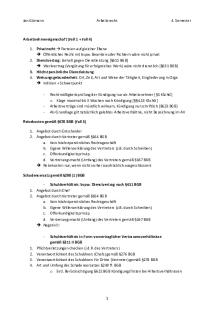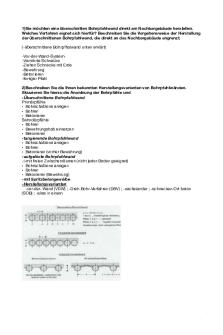Klausur ss09 solution engl PDF

| Title | Klausur ss09 solution engl |
|---|---|
| Author | Mihail Stoian |
| Course | Modellbildung und Simulation |
| Institution | Technische Universität München |
| Pages | 6 |
| File Size | 163.8 KB |
| File Type | |
| Total Downloads | 2 |
| Total Views | 135 |
Summary
Download Klausur ss09 solution engl PDF
Description
Klausur Modellbildung und Simulation (Prof. Bungartz) SS 2009 Name, Vorname:
Seite 1/6 Matrikelnummer:
1 Zufallsvariablen erzeugen (ca. 3 + 4 + 6 = 13 Punkte) Given n real numbers xi , i = 1, . . . , n from the interval (0, 1). The xi are ordered differently in pairs and in ascending order: 0 < x1 < x2 < . . . < xn < 1. As an example, we take n = 4 and the numbers 0.1, 0.2, 0.4, 0.8. Further, a random number generator R() is available which provides realizations of a random variable equally distributed to [0, 1]. a) For the sample data, sketch the emph empirical distribution function H(x), which specifies the proportion of data points that are at most as large as x: H(x) =
1 |{xi : xi ≤ x}| . n
b) Provide a method to produce realizations of a random variable X, which as distribution function FX has just the empirical distribution function H(x) (for general data records xi ).
We just need to pick one of the xi , each with a probability of 1/n: X := xi mit i := ⌈R() · n⌉ (i = 1 f¨ ur R() = 0)
Klausur Modellbildung und Simulation (Prof. Bungartz) SS 2009 Name, Vorname:
Seite 2/6
c) Now create a random variable Y whose distribution function FY has the following properties: – FY is steady. – FY (xi ) = H(xi ) for all data points xi , i = 1, . . . , n and let FY (0) = 0. – Between every two data points xi and xi+1 and between 0 and x1 , FY should be linear. Sketch FY and its associated density fY for the sample dataset and specify (for generic datasets xi ) a method to produce Y implementations.
Wir bestimmen wie gehabt i := ⌈R() · n⌉ (i = 1 f¨ur R() = 0), und sorgen daf¨ur, dass Y im Intervall [xi−1, xi ] landet (ab jetzt sei x0 := 0). Innerhalb des Intervalls muss es gleichverteilt sein: Y := xi−1 + R() · (xi − xi−1)
Klausur Modellbildung und Simulation (Prof. Bungartz) SS 2009 Name, Vorname:
Seite 3/6
2 Markovprozess, Systeme gew¨ohnlicher DGLn (ca. 2 + 5 + 2 + 6 = 15 Punkte) We consider a discrete homogeneous Markov process in continuous time with two states. The transition rate from state 1 to state 2 and vice versa is λ. a) Draw the transition diagram:
b) Now the system is in state 1 at the time t with a probability p1 (t) (0 leqp1 leq 1), that is with probability p2 (t) = 1 − p1 (t) in Condition 2. As in Sheet 7 ’Markov Chain Population Growth’, use the failure rate formula to specify the p1 (t + ∆t) and p2 (t + ∆t) probabilities in the Deltat tolimit0 depending on p1 (t), p2 (t) and ∆t.
ur den Wechsel des Zustands innerhalb von Die Wahrscheinlichkeit f¨ ∆t ergibt sich aus der Ausfallrate (die hier λ ist): p(T ≤ t + ∆t|T > t) = λ. ∆t→0 ∆t
hT (t) = lim
Somit ist im Grenzwert ∆t → 0 . p(1 → 2) = λp1∆t,
. p(2 → 1) = λp2∆t,
und weiter . p1(t + ∆t) = p1(t) − λp1(t)∆t + λp2(t)∆t, . p2(t + ∆t) = p2(t) + λp1(t)∆t − λp2(t)∆t.
Klausur Modellbildung und Simulation (Prof. Bungartz) SS 2009 Name, Vorname:
Seite 4/6
c) Give a system of differential equations describing the evolution of p1 (t), p2 (t). Note: if you have lost the thread in between, just continue to count up as a substitute −1 1 p1 p˙1 = . p˙2 1 −1 p2
Teil b) mit ∆t → 0 gibt −λ λ p1 p˙1 . = p2 λ −λ p˙2 d) Determine eigenvectors and eigenvalues of the system matrix of c), all equilibrium points and sketch the direction field in the bottom stationary coordinate system (very rough sketch for any lambda > 0). How do the solutions in the equilibrium points deal with small disturbances? What does this mean for the considered Markov process?
Eigenwerte (am einfachsten durch Ansehen der Matrix): 1 1 0 zu , und − 2λ zu , 1 −1 Gleichgewichtspunkte: p˙1 = p˙2 = 0 ⇔ p1 = p2. Das System ist orungen indifferent gegen¨uber St¨orungen in Richtung (1, 1)T , aber St¨ T in Richtung (1, −1) werden abgebaut. Markovprozess: hier bewegen wir uns auf einem Abschnitt der Geraden p1+p2 = 1, also f¨ur beliebige Startwerte auf den Punkt (1/2, 1/2)T zu (exponentieller Abfall der Entfernung zu (1/2, 1/2)T ).
Klausur Modellbildung und Simulation (Prof. Bungartz) SS 2009 Name, Vorname:
Seite 5/6
3 Numerik gew¨ohnlicher Differentialgleichungen (ca. 3 + 2 = 5 Pkt.) To get a numeric value for e = 2.71828 ldots, one can get out of the differential equation y(t) ˙ = y(t),
y(0) = 1
(1)
determine an approximation for y(1); since the solution to the equation is y(t) = et , we have an approximation for e. a) Give an explicit formula for the approximation etaN for y(1) depending on a N in N N, if Equation ( ref eq: ode) is numeric from t = 0 to t = 1 with the Euler method at a step size δt = 1/N is integrated.
b) How does the discretization error ηN − e behave in this method depending on δt? (O(. . .), just write down, do not deduce!) What does that mean for the ratio of computational effort to achieved accuracy?
Klausur Modellbildung und Simulation (Prof. Bungartz) SS 2009 Name, Vorname:
Seite 6/6
4 Wahlversprecher (about 4 + 3 = 7 points) In a poll for an electoral system that complies with the Democratic Basic Laws 1–4 (ie, the collective selection function is a figure PAn toPA that satisfies the Pareto condition and the independence of irrelevant alternatives), candidates will emerge x, y and z on. One week before the election, the result would be xyz, so x would win before y and z would land at the very end. Well, x forgets in an interview to categorically rule out tax hikes. Then all voters put x at the end of their new preference i′: Now y′i x and z′i x apply to all voters i. The preferences between y and z on the other hand remain the same for all voters. a) Which optional exits varrho′ are still possible? Justify your answer!
b) It may be that in the original opinion image (i or with xyz) x was not a voter favorite, ie v was foreachvoteryi x or zi x?
Nein: der Satz von Arrow besagt, dass es einen Diktator j geben muss. Dann gilt yj x ⇒ yx und zj x ⇒ zx, in keinem Fall w¨urde sich also das beobachtete Wahlergebnis einstellen....
Similar Free PDFs

Klausur ss09 solution engl
- 6 Pages

Solution (11) - Klausur DWT ss20
- 18 Pages

Klausur
- 2 Pages

Klausur
- 47 Pages

Klausur
- 6 Pages

Engl 1102 Coursework
- 1 Pages

ENGL 135 Course Outline
- 10 Pages

ENGL 1020 303 Syllabus
- 9 Pages

ENGL 50 Syllabus Updated
- 5 Pages

ENGL 227 Syllabus
- 5 Pages

ENGL 101 Blackbird analysis
- 2 Pages

Engl 101 educational argument
- 1 Pages

Engl-3219-Campus Journalism
- 14 Pages

ENGL 1111W Essay 1
- 6 Pages

Arbeitsrecht Klausur
- 3 Pages

Bohrpfahlwand Klausur
- 3 Pages
Popular Institutions
- Tinajero National High School - Annex
- Politeknik Caltex Riau
- Yokohama City University
- SGT University
- University of Al-Qadisiyah
- Divine Word College of Vigan
- Techniek College Rotterdam
- Universidade de Santiago
- Universiti Teknologi MARA Cawangan Johor Kampus Pasir Gudang
- Poltekkes Kemenkes Yogyakarta
- Baguio City National High School
- Colegio san marcos
- preparatoria uno
- Centro de Bachillerato Tecnológico Industrial y de Servicios No. 107
- Dalian Maritime University
- Quang Trung Secondary School
- Colegio Tecnológico en Informática
- Corporación Regional de Educación Superior
- Grupo CEDVA
- Dar Al Uloom University
- Centro de Estudios Preuniversitarios de la Universidad Nacional de Ingeniería
- 上智大学
- Aakash International School, Nuna Majara
- San Felipe Neri Catholic School
- Kang Chiao International School - New Taipei City
- Misamis Occidental National High School
- Institución Educativa Escuela Normal Juan Ladrilleros
- Kolehiyo ng Pantukan
- Batanes State College
- Instituto Continental
- Sekolah Menengah Kejuruan Kesehatan Kaltara (Tarakan)
- Colegio de La Inmaculada Concepcion - Cebu